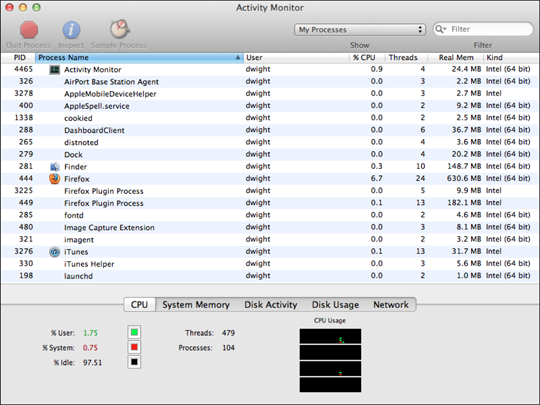Isolating Software Trouble
Let’s say you’re typing away in your favorite word processor and you suddenly see the wait cursor, known fondly as The Spinning Wheel of Death. The application crashes, and you lose about an hour’s worth of work because you forgot to save your document. Or, perhaps you are making a bank transaction in your favorite web browser when it freezes and you find out that your transaction was lost in the process. What do you do if you have an application that just won’t behave? Following are some questions and tips for troubleshooting a software issue:
![]() Have you installed the latest updates for your software? If not, visit the website of the application developer and see if there are any updates.
Have you installed the latest updates for your software? If not, visit the website of the application developer and see if there are any updates.
![]() Did the issue occur only after you installed an update (either for an application or Mac OS X)? Check with the application developer for any known issues with the update or to explain the issue you’re experiencing.
Did the issue occur only after you installed an update (either for an application or Mac OS X)? Check with the application developer for any known issues with the update or to explain the issue you’re experiencing.
![]() Do you experience problems with only one document? There may be an element in that particular document, such as a font or graphic, that is corrupted and causing the issue. Try creating a new document, copy and paste elements from the old document into the new one, and see if the issue is resolved.
Do you experience problems with only one document? There may be an element in that particular document, such as a font or graphic, that is corrupted and causing the issue. Try creating a new document, copy and paste elements from the old document into the new one, and see if the issue is resolved.
![]() Do you get a specific error message? If so, consult the application documentation or the manufacturer’s website for help interpreting the message.
Do you get a specific error message? If so, consult the application documentation or the manufacturer’s website for help interpreting the message.
![]() Is the issue related to a software/hardware combination (such as a certain scanner or camera) with a particular application? For example, if you have a problem with Image Capture crashing when you try to import images from your camera, check to see if you can import images with a different application. If other applications also have this issue, see if another camera works. If other applications do not exhibit the problem, it’s quite likely that the single misbehaving application is the culprit.
Is the issue related to a software/hardware combination (such as a certain scanner or camera) with a particular application? For example, if you have a problem with Image Capture crashing when you try to import images from your camera, check to see if you can import images with a different application. If other applications also have this issue, see if another camera works. If other applications do not exhibit the problem, it’s quite likely that the single misbehaving application is the culprit.
![]() Discard the application’s preferences files. Consult the application documentation or contact the manufacturer to find out where the application stores its preferences in Mountain Lion. When you restart the application, new preference files are created. You may need to check your preferences to make sure that they are set the way you want them to be. Should you need to go to the Library folder, press the Option key, click the Go menu, and select Library to open a Finder window in the Library folder.
Discard the application’s preferences files. Consult the application documentation or contact the manufacturer to find out where the application stores its preferences in Mountain Lion. When you restart the application, new preference files are created. You may need to check your preferences to make sure that they are set the way you want them to be. Should you need to go to the Library folder, press the Option key, click the Go menu, and select Library to open a Finder window in the Library folder.
![]() Is the application frozen? If so, force it to quit by pressing
Is the application frozen? If so, force it to quit by pressing ![]() +Option+Esc. Select the offending application from the list in the Force Quit Applications window and click Force Quit.
+Option+Esc. Select the offending application from the list in the Force Quit Applications window and click Force Quit.
Unfortunately, if the issue isn’t cleared up by now, you may need to reinstall the application. Again, be sure to contact the manufacturer or read the documentation included with the application to see if there are any special instructions that you need to follow to properly reinstall it.
Utilizing the root account
Sometimes the problem is that something has become corrupted in your user account. To find out, log in to a different account and see if the issue persists. I prefer to use the root account, which gives you complete control over the Mac. Follow these steps:
1. Open Directory Utility, which is found in the System/Library/CoreServices folder.
2. Click the lock icon in the lower-left corner (see Figure 16.2). Type your username and password when prompted.

16.2 Click the lock to make changes to the Directory Utility.
3. Choose Edit→Enable Root User to enable the root account.
4. Type the root account password twice to confirm it. Do not forget this password!
5. Quit Directory Utility.
6. Log out of the account you are currently using.
7. In the login window, click Other.
8. Type root for the username and then type the password you assigned to the root account in Step 4.
9. To log in to the root account, click Log In (found in the lower-right corner).
10. Test your issue while logged in as root. If the symptom persists, it is a system-wide problem. If the issue does not present itself while logged in as root, you’ve isolated the problem to the account you were previously using.
Deleting preference files
Most applications installed on a Mac create preference files somewhere on the system. These files tell the application how it should behave, what customizations have been made, what passwords may be necessary for someone to use it, and lots of other information it may need to function properly. If these preference files (there may be more than one, depending on the application) have been corrupted, your application may engage in some very odd behavior. In fact, it may not start up at all. If this is the case:
1. Contact the developer of the application to find out what preference files are used by the app and where you can find them on your Mac.
2. Find the preference files and delete them.
3. Reopen the offending application, and the preference file(s) will be correctly rebuilt.
Killing a process
If your Mac is super-sluggish, there may be an errant application hogging up all of the memory. When this happens, you could restart your Mac to effectively kill all processes and start over. If you have other tasks running that you need to leave alone, Apple has made Activity Monitor for just such occasions.
To find and stop a memory-hogging process via Activity Monitor, follow these steps:
1. From the Finder, press ![]() +Shift+U to open the Utilities folder.
+Shift+U to open the Utilities folder.
2. Double-click the icon for Activity Monitor.
3. Browse through the processes list (see Figure 16.3) and see if there are any processes using a large percentage of the computer’s cycles. To see the percentage being used by each process, look under the % CPU heading. You can click the % CPU heading to arrange the processes by the highest percentages.
4. Highlight the offending process and click the Quit Process button to stop it in its tracks.

16.3 Activity Monitor keeps up with all of the processes running on your Mac.
Correcting permissions issues
Every file in OS X has a set of permissions assigned to it. These tell Mountain Lion exactly who can access the file and how he can use it. Sometimes these permissions can get a little out of sorts and need to be repaired in order for your Mac to function in its normally spectacular way. Here are some symptoms to look for:
![]() You are unable to empty a file from the Trash.
You are unable to empty a file from the Trash.
![]() An application can only be launched by one user account even though it is installed for use on all accounts.
An application can only be launched by one user account even though it is installed for use on all accounts.
![]() You cannot open a document that you know you should be able to open.
You cannot open a document that you know you should be able to open.
![]() The Finder restarts when you are trying to change permissions for a file.
The Finder restarts when you are trying to change permissions for a file.
![]() You are unable to open folders on your Mac (or the network) to which you are supposed to have access.
You are unable to open folders on your Mac (or the network) to which you are supposed to have access.
![]() An application crashes when you try to print from it.
An application crashes when you try to print from it.
There are several other issues that may be related to permissions problems as well, but these are the most common. Repairing permissions is, thankfully, an easy task to accomplish. Follow these steps:
1. In the Finder, open Disk Utility by pressing ![]() +Shift+U and double-clicking its icon.
+Shift+U and double-clicking its icon.
2. Select the drive that contains the files with the permissions issues.
3. Click Repair Disk Permissions in the lower-left corner of the First Aid tab. The process of repairing the permissions begins, as shown in Figure 16.4.

16.4 Restoring permissions to their proper states.

You can also run Disk Utility from within Mountain Lion’s recovery mode. To boot a Mac into recovery mode, restart the Mac, immediately begin holding down the ![]() and R keys, and let go of the keys after you see the white screen with the gray Apple logo. Once into recovery mode, choose Utilities→Disk Utility and run the repair as described in the previous steps.
and R keys, and let go of the keys after you see the white screen with the gray Apple logo. Once into recovery mode, choose Utilities→Disk Utility and run the repair as described in the previous steps.
